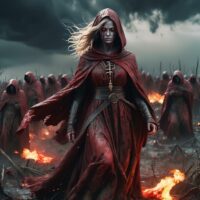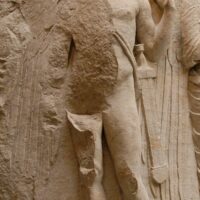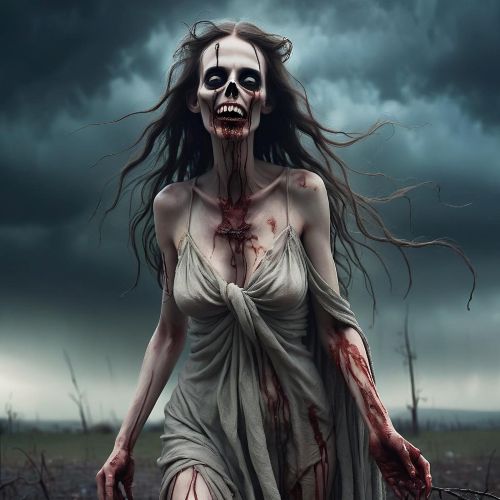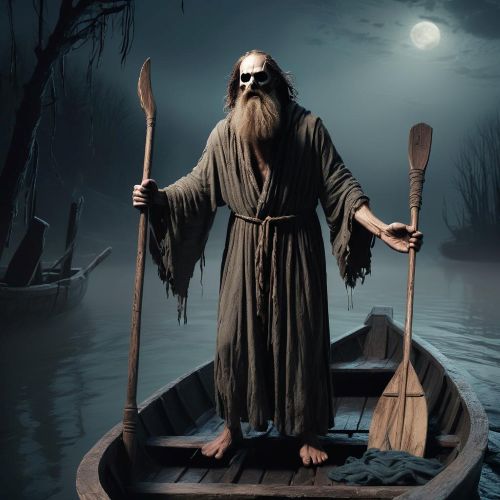Androktasiai : Spirits of the Battlefield
Listen
At a glance
| Description | |
|---|---|
| Origin | Greek Mythology |
| Classification | Spirits |
| Family Members | Eris (Mother) |
| Region | Greece |
| Associated With | Death on the Battlefield |
Androktasiai
Introduction
In Greek mythology, the Androktasiai (Ancient Greek: Ἀνδροκτασίαι) are terrifying personifications of manslaughter, embodying the indiscriminate killing of men in battle. They are depicted as female daimones born from Eris, the goddess of strife, and serve as symbolic reminders of the chaos and destruction inherent in war. Unlike gods of strategy or heroic combat, the Androktasiai represent the grim reality of battlefield death, illustrating the ancient Greek understanding of violence as a destructive and almost supernatural force. Their presence in Hesiod’s Theogony and Homer’s Odyssey reflects the cultural recognition that war unleashes forces beyond human control, personified in these abstract, fearsome spirits. The singular form, Androktasia, also appears in works like the Shield of Heracles, alongside other personifications such as Pursuit, Tumult, and Murder, emphasizing the various forms of suffering that arise from conflict.
Physical Traits
The Androktasiai are primarily conceptual figures, and classical sources provide little in the way of concrete physical descriptions. Their significance lies in what they represent rather than what they look like. In Hesiod’s Shield of Heracles, Androktasia is portrayed as one of many forces moving through the chaos of war, suggesting a spectral or ghostly presence rather than a human form. Ancient art rarely depicts her, leaving room for imaginative interpretation. In modern interpretations, writers and fanon works sometimes give them distinctive features to reflect their deadly essence. For instance, descendants or avatars of the Androktasiai are often described as wearing black, form-fitting garments designed for stealth and efficiency, carrying light weapons like daggers rather than bulky armor, and displaying a cold, disciplined demeanor. In some fantasy retellings, the Androktasiai or their progeny may take on supernatural traits, such as multiple eyes or ethereal colors like blue and purple to signify their otherworldly power, reinforcing their connection to death and combat rather than ordinary humanity. These representations emphasize that the Androktasiai are embodiments of concepts—chaos, fear, and the lethality of battle—rather than beings defined by traditional human traits.
Family
The Androktasiai are daughters of Eris, the goddess of strife, who herself has no recorded father in Hesiod’s genealogies. They are part of a larger family of personified forces that encapsulate suffering, conflict, and moral decay. Their siblings include Ponos (Toil), Algea (Pains), Hysminai (Fightings), Makhai (Battles), Phonoi (Murders), Limos (Starvation), Neikea (Quarrels), Pseudologoi (Lies), Amphilogiai (Disputes), Dysnomia (Lawlessness), Ate (Ruin), Lethe (Forgetfulness), and Horkos (Oath). While the Phonoi represent murder in general, the Androktasiai are uniquely associated with killings that occur during combat, reflecting a Greek distinction between the chaos of battle and individual acts of homicide. This familial context situates the Androktasiai within a mythological framework where strife gives birth to numerous destructive consequences, each embodying a specific aspect of human suffering or moral disorder.
Other names
The name “Androktasiai” translates to “manslaughters,” “slayings of men,” or “manslayings,” emphasizing their role as collective embodiments of battlefield death. The singular, Androktasia, refers to a single instance of this personification. Ancient texts rarely assign individual names to the Androktasiai, reflecting their nature as abstract forces rather than personal deities. In Homeric epics, the term can also appear more generally, used to denote the casualties of war or the brief, tragic lives lost in battle. The name itself carries weight as a literal description of the act they personify, reinforcing the Greek tendency to conceptualize intangible horrors like death and chaos in mythological form. The Androktasiai are thus less characters and more living metaphors, giving shape and identity to the universal experience of combat-related death.
Powers and Abilities
The Androktasiai’s power lies not in wielding weapons or commanding armies, but in their symbolic dominion over the chaos and lethality of war. In myth, they are responsible for the deaths of men on the battlefield, a role that reflects the indiscriminate, devastating nature of combat. Hesiod’s Theogony and the Shield of Heracles depict them as companions of other war-associated spirits, feeding off the confusion, fear, and bloodshed that accompany conflict. In modern adaptations, these personifications are sometimes endowed with additional supernatural abilities. For example, progeny of the Androktasiai in fanon settings may have heightened senses, invisibility at twilight, or uncanny lethality with minimal effort, representing the psychological and strategic advantages of lethal precision. In more fantastical depictions, they might manifest extraordinary traits like thousands of eyes opening at adulthood, symbolizing the awakening of destructive potential. Whether in classical or contemporary narratives, the Androktasiai serve as embodiments of the indiscriminate, inexorable force of death in battle, a reminder that war’s consequences extend beyond human control.
Modern Day Influence
Though largely obscure in mainstream media, the Androktasiai’s symbolic legacy endures. Writers, scholars, and creators draw upon their archetype to explore the psychological and moral dimensions of warfare. In literature and poetry, they echo the horrors of senseless killing, the trauma of soldiers, and the human cost of conflict. In academic discussions, they provide insight into ancient Greek conceptions of morality, war, and fate, illustrating how the Greeks personified the darker aspects of human existence. In role-playing games, fanon wikis, and fantasy storytelling, the Androktasiai inspire characters, powers, and settings that reflect their lethal efficiency, coldness, and association with death. Themes associated with them—chaos, fear, and the brutality of battle—resonate with modern audiences exploring the darker aspects of human nature. Their enduring relevance lies in the universal experience they represent: the destructive and uncontrollable forces that arise whenever conflict erupts. Through the Androktasiai, ancient Greek myth continues to illuminate not just the mythic past but the enduring human fascination with violence, mortality, and the psychological dimensions of strife.
Related Images
Source
Caldwell, R. (1987). Hesiod’s Theogony. Focus Publishing/R. Pullins Company.
Gantz, T. (1996). Early Greek Myth: A Guide to Literary and Artistic Sources. Johns Hopkins University Press.
Hard, R. (2004). The Routledge Handbook of Greek Mythology: Based on H.J. Rose’s Handbook of Greek Mythology. Psychology Press.
Hesiod. (c. 700 BCE). Theogony and Shield of Heracles. Translated by H.G. Evelyn-White.
Fandom. (n.d.). Androktasiai – Myths of the World Wiki. Retrieved from https://mythworld.fandom.com/wiki/Androktasiai
Graf, F. (1993). Greek Mythology: An Introduction.
GreekMythology.com. (n.d.). Androktasiai – Greek Mythology. Retrieved from https://www.greekmythology.com/Other_Gods/Minor_Gods/Androktasiai/androktasiai.html
Hard, R. (2004). The Routledge Handbook of Greek Mythology: Based on H.J. Rose’s
Wikipedia. (2010, March 25). Androktasiai – Wikipedia. Retrieved from https://en.wikipedia.org/wiki/Androktasiai
www.heirtothestars.com. (n.d.). Androktasiai. Retrieved from https://heirtothestars.com/androktasiai/
Frequently Asked Questions
What is lorem Ipsum?
I am text block. Click edit button to change this text. Lorem ipsum dolor sit amet, consectetur adipiscing elit. Ut elit tellus, luctus nec ullamcorper mattis, pulvinar dapibus leo.
What is lorem Ipsum?
I am text block. Click edit button to change this text. Lorem ipsum dolor sit amet, consectetur adipiscing elit. Ut elit tellus, luctus nec ullamcorper mattis, pulvinar dapibus leo.
What is lorem Ipsum?
I am text block. Click edit button to change this text. Lorem ipsum dolor sit amet, consectetur adipiscing elit. Ut elit tellus, luctus nec ullamcorper mattis, pulvinar dapibus leo.
What is lorem Ipsum?
I am text block. Click edit button to change this text. Lorem ipsum dolor sit amet, consectetur adipiscing elit. Ut elit tellus, luctus nec ullamcorper mattis, pulvinar dapibus leo.
What is lorem Ipsum?
I am text block. Click edit button to change this text. Lorem ipsum dolor sit amet, consectetur adipiscing elit. Ut elit tellus, luctus nec ullamcorper mattis, pulvinar dapibus leo.











